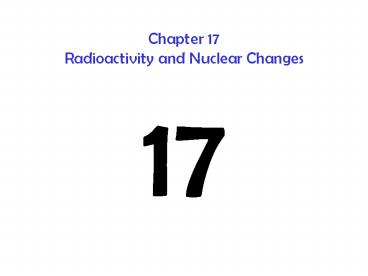Chapter 17 Radioactivity and Nuclear Changes - PowerPoint PPT Presentation
1 / 24
Title:
Chapter 17 Radioactivity and Nuclear Changes
Description:
Kinds of Chemistry Author: Paul S. Russo Last modified by: Paul Russo ... All those isotopes are why the mass numbers for an atom are not simple integers. – PowerPoint PPT presentation
Number of Views:176
Avg rating:3.0/5.0
Title: Chapter 17 Radioactivity and Nuclear Changes
1
Chapter 17Radioactivity and Nuclear Changes
- 17
2
Why do I have to know this stuff?
- We could all be vaporized.
- Ornuclear energy could be our salvation.
- How old is that fossil?
- Can we treat that tumor?
- Radon (a bigger problem elsewhere)
- Food preservation (refrigerated, is it safe after
3 days or 3 weeks?)
3
Is grandma losing her mind?
PET images courtesy of the Alzheimer's Disease Education and Referral Center/National Institute on Aging Postmortem images courtesy of Edward C. Klatt, Florida State University College of Medicine
Positron emission tomography Age 20 -- 80
Normal -- 80 with Alzheimers
Postmortem Coronal Sections Normal Alzheimers
4
There are important differences between chemical
and nuclear reactions lets begin with this
chemical reaction.
CCl4 H ? CCl3H Cl
Chemical Reactionlets do it by Lewis Dots
Note no atoms lost, just rearranged.
5
Now heres a nuclear reaction.
CCl4 ? NCl4 1 e-
Carbon turned to Nitrogen. Can it do that?
6
(No Transcript)
7
Becquerels Experiment
Antoine Henri Becquerel Comptes Rendus 122, 420
(1896) Nobel 1903 with P. M. Curie
Mr. B was studying phosphorescent light.
Was it the same as ordinary light?
Would it expose photographic film in the same
way? Today, we know it willbut
Mr. Bs source was rocks. He
placed certain ordinary non-phosphorescent
rocks.and they exposed the film, too! This
was true even if the
film was shielded from normal light.
Image Wikipedia
8
Serendipity means lucky.
The greatest results often come just when we
aren't looking for them. In fact, looking for
some specific result can blind you to more
important things. Most scientists struggle
with this problem, especially today because
science has become a means to an end.
9
Nuclear Reactions Convert Small Amounts of Mass
to Energy
E mc2
Chocolate bar 35 g 0.035 kg Nuclear Energy
(0.035 kg)(3 x 108 m/s)2 3 x 1015
Joule Chemical Energy 200 food cal 200,000
cal 800,000 Joule Nuclear energy 4 billion
times greater! But it is not so easy to convert
chocolate to energy especially if you want to do
it quickly.
10
Why atomic weapons are so powerful
It is possible to convert a fairly small portion
of some isotopes of some elements (uranium,
plutonium, hydrogen) into energy. Even though
the portion of matter converted is small, the
bang is pretty large because. the conversion
process is very quick. Energy changes that
happen quickly imply high power. A populace
that is burning millions of candy bars can equal
the energy of a nuclear bomb, but not the
power. Also, the A-bomb is small, concentrated
energy, whereas all the people to burn those
candy bars would be spread out.
11
Atomic weapons resultsfriend or foe?
Runt 1, a very large nuclear weapon
It is possible for such weapons to produce
craters 250 feet deep, more than one mile
wide. Is it possible for them never to be
used again?
Castle Romeo Test Shot
From the Gallery of U.S. Nuclear Tests
http//www.fas.org/nuke/hew/Usa/Tests/index.html
12
Meet the Nucleons. (kind of a repeat)
13
The symbols are designed to help us track nuclear
reactions.
All symbols have this meaning. Upper left
mass in multiples of hydrogen mass Lower
left charge Main symbol an atomic
symbol or n for neutron, etc.
14
There are only 100 or so elements, but many have
multiple isotopes, some are radioactive.
stableand unstable may be inverted on this
figure. Someone want to look that up?
Figure 5.3 (stable unstable isotopes)
15
All those isotopes are why the mass numbers for
an atom are not simple integers.
average mass of carbon 12.01 the 12 isotope
is very common, and only small portions of the
fatter isotopes are found. the 13 isotope is
useful for identifying compounds in nuclear
magnetic resonance. the 14 isotope is useful
for radioactive dating of ancient objects.
16
Rules for nuclear reactions
The total mass does not change The total charge
does not change
Except for the tiny amount converted to pure
energy, as discussed already.
17
Work some of the examples in the noteswrite them
on ELMO
18
Types of nuclear processes are referred to by the
ray or particle they produce.
Nuclei can eject protons or helium nuclei get
lighter (alpha decay). They can swallow a
neutron spit out the electron to get heavier
(beta decay). Whenever the of protons
changes, the atom type has changed.
19
Figure 5.6 Uranium Decay Path
20
Where does a 900-pound gorilla sit?
When does radioactive decay occur?
Decay eventse.g. electrons detected for beta
decaymost probable at first
Half-life
21
Half-life Problems
22
Practical nuclear reactions
Fusion example (sunlight, future perfect energy
source?)
4 hydrogens ? 1 alpha 2 positrons 2 gammas
2 neutrinos ENERGY
- Fission example (atomic bombs, power plants)
- 235U 1n ? 134Xe 100Sr 2 1n
energy
http//www.lbl.gov/abc/Basic.html
23
LSU Peptide-based Alzheimer Inhibitors
AMY-1 x 1, y 6 AMY-2 x 6, y 1 AMY-3 x
1, y 1
Mediators Developed by Professor Robert Hammer
Professor Mark McLaughlin
24
Stop here?































